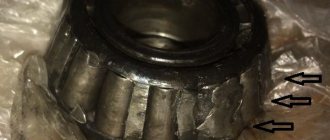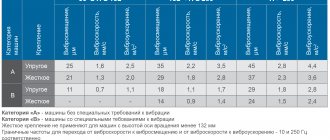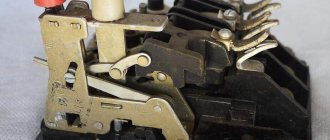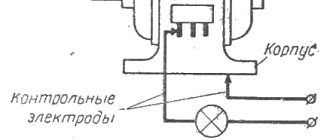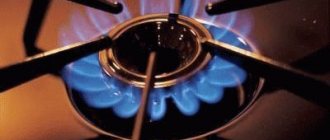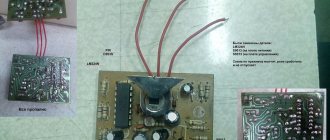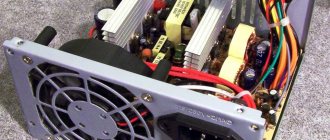Causes of engine overheating
Heating can be caused by a variety of factors. Most often this is due to:
- Operation in an unacceptable mode. The device should not operate for a long time under increased load, nor should it be subjected to mechanical stress (shocks, sharp shocks, vibration) - this will compromise its integrity.
- Corrosion caused by sudden and frequent temperature changes and high humidity. Reducing the gap between elements due to rust leads to the fact that the electric motor does not gain speed and heats up.
- Failure to comply with storage, installation and transportation rules. The instructions given in the passport must be strictly followed.
- Damage to winding insulation. This can occur when foreign particles get under the housing or during careless transportation. The consequences are different - local short circuits, shaft deformation, uneven rotation of the rotor, and as a result - overheating.
- Operation at high or low voltage in the network. Trying to find the answer to the question: why does a 3-phase electric motor heat up, check the wiring and the condition of the sockets.
- Clogged ventilation ducts. To avoid this, it is enough to regularly inspect and clean the engine.
- Constantly too high/low temperature in the room where the engine operates.
- Bearing failure. Signs of this malfunction are immobility or poor rotation of the rotor when the device is turned on, complete jamming of the rotor and stator, and heating of the housing.
In most cases, heating of the motor winding can be prevented simply by strictly following the operating rules. Sometimes it is enough to turn it off and leave it at rest for a while. If the elements are already damaged, they need to be repaired or replaced.
Subscribe to the newsletter
During operation, the electric motor may begin to heat up. This problem should be treated with increased attention, since the winding insulation cannot withstand high temperatures. In most cases, it is designed for normal daily operation within 90-95ºС. Some motors are created using windings for which the critical temperature is 130ºC. If emergency overloads or technological malfunctions occur during operation, the motor will begin to heat up, and the winding insulation will fail as a result. The next stage in the development of the situation will most likely be a short circuit, which will lead to the need for expensive repairs. To prevent this from happening, it is necessary to find out why the electric motor and eliminate the causes. In most cases, this is less expensive than ordering a rewind or buying a new motor.
The main reasons for engine overheating The reasons why an engine may overheat can lie in a variety of planes. The main ones include:
- malfunction of the electric current supply line;
- high workload;
- wear of electric motor brushes;
- shaft misalignment;
- bearing wear or poor lubrication;
- Engine cooling fan malfunction.
You can find out why the electric motor is heating up by turning it on without load. But before that, it’s worth studying the motor’s passport, which indicates the maximum load. If it does not correspond to the actual one, then it is worth trying to reduce the amount of work performed by the power unit. When a motor connected without load works perfectly, the problem is only due to incorrect technological processes. If the engine heats up without load, then the reasons are probably inside the power unit. Some of them are quite easy to fix, for example, if it's all about the fan cooling the rotor. It can become clogged with dust and clean it enough for the operating temperature to become normal again. Basic ways to eliminate engine heating Having found out the cause of engine heating, you should definitely eliminate the malfunction. Otherwise, the service life of the engine can be reduced several times. The most commonly used methods for eliminating heating of electric motors are bearing lubrication, stabilizing the voltage in the network supplying the power unit, and removing dust and dirt from the surface of the winding. If the voltage cannot be equalized, then the load on the engine should be reduced. Normal operation of the motor is possible only if the voltage is at least 80% of the rated voltage. More complex causes of motor heating are eliminated in specialized workshops, where brushes are cleaned or replaced, and new motor windings are made. What to do if the electric motor bearing gets hot? For normal operation, care must be taken to keep it clean. Make sure the bearing caps are tightly closed. If they opened due to strong vibration, then dust, dirt or debris probably got into them. For further operation of the bearing, it is necessary to remove the contaminated lubricant, thoroughly rinse the part with kerosene, and blow with compressed air. After this, it is necessary to fill the bearing with lubricant - one that corresponds to the speed of the engine. It is added in small portions using special devices. You cannot overdo it with the amount of lubricant, since sliding in this case will be difficult and the electric motor will again experience increased load.
Source
Connection diagram for a three-phase motor via a capacitor
Here, the voltage of 220 volts is distributed into 2 series-connected windings, where each is designed for this voltage. Therefore, the power is lost almost twice, but such an engine can be used in many low-power devices.
It is important to remember: three-phase electric motors have higher efficiency than single-phase 220 V motors. Therefore, if there is a 380 V input, be sure to connect to it - this will ensure more stable and economical operation of the devices
To start the motor, you will not need various starters and windings, because a rotating magnetic field appears in the stator immediately after connecting to a 380 V network.
A 3-phase motor connected to 220 V is heating up
Many craftsmen connect a three-phase motor using 220 V capacitors. Subsequently, they complain that the unit is heating up for some reason.
There could be several explanations for this:
- Interturn short circuit of windings.
- Wrong choice of capacitor (by capacity, type).
- Error in connection diagram.
- Lack of sufficient cooling (important for high-power engines).
- Long periods of idling.
The remaining problems are the same as in other types of electric motors.
Loss of power and engine response, reasons related to the ignition system
The car doesn’t drive, it pulls poorly, it feels like someone is holding it from behind, you press the gas all the way to the floor, and the engine response is sluggish. Similar statements are typical of many motorists who are faced with a drop in power and throttle response of a car engine. There can be many reasons for this malfunction (carburetor, power system, engine itself, etc.). In this article we will look at the reasons for the drop in power and throttle response of a carburetor car engine associated with the ignition system.
Almost always, most car repairmen recommend first fixing problems with the ignition system, and then getting into the carburetor and other systems. As an example for troubleshooting, let's take the carburetor engines of front-wheel drive VAZ 2108, 2109, 21099 cars with a contactless ignition system.
The main reasons for the drop in power and throttle response of the carburetor engine of VAZ 2108, 2109, 21099 cars associated with the ignition system
— The ignition timing is set incorrectly
If the ignition is too early, the engine will pick up well at the low end, but as it accelerates, the car's dynamics will deteriorate sharply. Detonation will be heard (“fingers knock”) when you press the gas pedal.
Ignition too late, on the contrary, reduces throttle response at low speeds and during acceleration, and at medium and heavy loads the car can drive more or less acceptable. Here the problem is mitigated by a rich fuel mixture and the entry into operation of the vacuum and centrifugal ignition timing regulators, making the timing earlier.
The ignition timing must be checked and set correctly first (See “Setting the ignition timing on engines of VAZ 2108, 2109, 21099”). Initially, it can be adjusted by rotating the distributor relative to the scale: to the left - earlier ignition, to the right - later (see photo at the beginning of the article).
— Sticking weights or loosening of the springs of the centrifugal advance regulator in the distributor
The centrifugal regulator makes ignition earlier as engine speed increases due to the divergence of weights held by springs. If the weights get stuck or the springs break, the advance angle will remain the same, but the car engine needs earlier angles to gain power and throttle response. Accordingly, one cannot expect any improvement in dynamics from the car.
To fix the problem, you will have to remove the distributor, remove the centrifugal regulator and replace the weights and springs with new ones. In some cases, you can get by with simply cleaning the parts. See “Centrifugal ignition timing regulator for VAZ 2108, 2109, 21099”.
operation of the centrifugal ignition timing regulator for VAZ 2108, 2109, 21099 cars
— The vacuum supply tube to the vacuum ignition timing regulator in the distributor has fallen off or is leaking
The vacuum ignition timing regulator also makes the ignition slightly earlier at power levels in order to increase the efficiency of the engine. For example, if a car pulls poorly on a hill, then one of the most likely causes will be a failure of the vacuum regulator.
The design of the vacuum regulator must be completely sealed (housing, tube). Therefore, first of all, we check the vacuum supply tube, the tightness of its fit on the carburetor fitting and on the fitting of the vacuum regulator housing on the distributor. If the diaphragm in the regulator body is broken, it must be replaced with a new one. We also remove the distributor cover and the protective screen and check the fastening and clear movement of the regulator rod. For more details, see “Vacuum ignition timing regulator for VAZ 2108, 2109, 21099”.
Methods for accounting for equipment wear
Next, it is advisable to move on to the final aspect of such a broad topic as the wear and tear of production mechanisms, equipment, products and their individual components. Depreciation charges, which are intended to compensate for the aging processes of equipment, can now also be determined using a number of methods:
- Proportional or linear calculation.
- Reducing balance method.
- Calculation made in accordance with the period of production use.
- Calculation carried out according to the volume of the released product.
It is important to know that the choice of a specific technique is implemented during the formation or deep reorganization of the structure. It is necessarily fixed in the accounting policy of the enterprise
The operation of production mechanisms, equipment and miscellaneous products in accordance with generally accepted rules and regulations, as well as sufficient and timely contributions to depreciation funds, one way or another, allow organizations to maintain economic and technological efficiency at a competitive level. As a result, structures can continuously bring joy to their consumers with high-quality commercial products at reasonable prices.
Interpretation
Certain norms for the depreciation coefficient are not prescribed in any legislative documents. As noted above, the meaning of this indicator is purely analytical. However, the standard value must be determined for each specific organization and recorded in internal documentation defining accounting policies. This means that the limit value of wear must be determined, at which the degree of “used” is considered high enough to begin to take any measures: make a decision on repairs or an immediate future replacement.
REFERENCE! Most companies charge an average standard depreciation rate of 50%. That is, if the coefficient does not exceed this figure, it is considered that the condition of this product is within the established norm. Exceeding this indicator indicates the need for management decisions related to fixed assets.
If the depreciation rate is within the normal range, but approaching 50%, it is advisable to further evaluate the condition of the funds separately for each group or even for each individual unit.
Is it possible to set any value as a norm?
If a different figure is commonly used in the industry, reflecting the standard indicator of wear and tear, the enterprise can set its own value that differs from the generally accepted one. But in this case, the calculated indicator will differ from the real picture within the specifics of a particular industry. So it is advisable to adhere to the standards developed by production practice, even if not fixed by law.
Permissible heating temperature
Overheating of the electric motor housing is one of the main parameters indicating its serviceability, as well as the normal operation of the actuator. The permissible temperature of the device is indicated in the electric motor passport; there are models for which the norm is 100°C, but most often the maximum permissible heating is 60°C and constantly exceeding this indicator by only 10°C reduces the service life of the windings by 2 times. Overheating of the device leads to the following negative consequences:
- drying out of insulating materials;
- destruction of varnish on winding wires;
- interturn and interwinding short circuit.
To prevent such situations during the operation of the mechanism, electricians on duty and process personnel need to regularly monitor the temperature. To do this, it is advisable to use a non-contact thermometer, but it is permissible to use the method used in Soviet times - if you can hold your hand on the body of the electric machine, then there is no overheating. Advice! Tactile temperature measurement is performed with the back of the hand. This is necessary to prevent “sticking” in the event of a phase short circuit to the housing.
Comparison of synchronous and asynchronous electric motors
Both types of this equipment operate on alternating current. The speed of synchronous motors is constant, the frequency of rotation of the magnetic field is equal to the speed of rotation of the rotor.
- power factor up to 0.9;
- Efficiency is 1-3% higher than that of asynchronous equipment;
- high strength due to a relatively large air gap;
- low sensitivity to power surges;
- Can be used to improve power factor in production.
Important! The disadvantages include the relatively high cost and complexity of the equipment used to launch
- graphite brushes and bearings (wear out quickly);
- relatively weak spring for pressing the brushes to the commutator;
- thinly removable ring, prone to the accumulation of dirt deposits.
Brushes require special attention. If the graphite is completely worn away, the slip ring is damaged. If it fails, the engine stops functioning.
In asynchronous motors, the rotational speed of the magnetic field is different from the rotational speed of the rotor. The design is simple, operation is more reliable. In the absence of overloads, this equipment lasts a long time.
Advantages of asynchronous design:
- ease of production;
- relatively low cost;
- minimum operating costs;
- connection to the network without converters (if there is no need to regulate the speed).
When choosing, you need to consider the disadvantages:
- low power factor and efficiency (compared to synchronous models);
- increased dependence on voltage in the electrical network;
- high starting current and low starting torque;
- inability to adjust the speed if connected directly to the network.
Attention! The most vulnerable point is the bearings, but replacing them does not create problems
So, why does an electric motor get hot and how can you prevent it from overheating?
The problem of motor heating must be treated with special attention, because the insulation of its windings has little resistance to elevated temperatures. Often the norm is a temperature in the range of 90-95 ºС. There are electric motors with windings designed for a maximum temperature of 130 ºС. But in any case, during operation, emergency overloads or technological malfunctions may occur, which lead to heating, which causes insulation failure. After which a short circuit often occurs. As a result, to restore the device’s functionality, expensive engine repairs or its complete replacement will be required. It will be less expensive to find out the reason for the heating of the electric motor and eliminate it than to buy a new motor or order its rewinding.
Often the cause of engine overheating is:
- faulty power lines;
- increased workloads;
- wear of electric motor brushes;
- shaft misalignment;
- poor lubrication and increased wear of bearings;
- failure or ineffective operation of the engine cooling device (fan).
You can find out the reason for the heating of the motor if you turn it on without load.
But first you need to study the passport of this device, which reflects information about the maximum load. If it is greater than the actual value, you must first reduce the volume of work performed by the unit. Improper technological installation is indicated by ideal engine operation without load. But if it heats up without load, then the reasons lie inside this unit.
Many of them are not difficult to eliminate, for example, if the cause of the temperature increase is a non-working cooling fan. It may be poorly lubricated or clogged with dust, and to restore its normal operation you just need to lubricate or clean the fan from dust. Regardless of what caused the increase in the temperature of the electric motor, this malfunction must be eliminated as soon as possible. Since further operation of the engine can lead to more serious problems, its service life will be reduced several times. Most often, the problem of increased temperature of an electric motor is solved by lubricating the bearing, stabilizing the voltage in the electrical network that powers a particular power unit, and removing dirt and dust from the winding surfaces. If it is not possible to equalize the voltage in the network, it is necessary to reduce the load on the motor. In this case, it will function normally at a voltage that is no more than 20% less than the rated voltage. Elimination of more complex causes of heating is carried out by cleaning or replacing brushes and rewinding the motor.
Reasons for changes in the technical condition of cars during operation
Changes in technical condition are caused by the operation of mechanical components, random reasons, as well as the influence of external conditions of operation and storage of the vehicle. Random causes include hidden defects, structural overloads, etc.
The main permanent causes of changes in the technical condition of parts and the car as a whole are wear, plastic deformation, fatigue failure, corrosion, physical and chemical changes in the material of parts
During vehicle operation, the value of design and diagnostic parameters varies from initial values to permissible values and then to maximum values, which are regulated by GOSTs. Operating time of a product to the limiting state of a certain technical level. documentation is called a technical resource. The state of the product when it is capable of performing the specified functions with the parameters of the value to the established technical. doc., called efficiency.
yN-normal, yP-limit, yi≥yP-failure (cessation of the transport process), other deviations are malfunctions.
Wear is the process of destruction and separation of material from the surface of a part and (or) accumulation of its residual deformation during friction, manifested in a gradual change in the size and shape of parts. The result of wear, defined in established units (for example, µm/km), is called wear.
Typically, in TEA practice, abrasive, fatigue, corrosion-erosion, oxidation, electrical erosion, as well as wear due to seizing, fretting and fretting corrosion are distinguished.
Plastic deformation and fracture. Such damage is associated with reaching or exceeding the yield or strength limits of ductile (steel) or brittle (cast iron) materials, respectively. Typically, this type of destruction is the result of either errors in calculations or violations of operating rules (overloads, improper driving, traffic accidents, etc.). Sometimes plastic deformations or fractures are preceded by mechanical wear, leading to a change in geometric dimensions and a reduction in the safety margins of the part.
Fatigue failures. This type of failure occurs when loads are cyclically applied that exceed the endurance limit of the metal of the part. In this case, a gradual accumulation and growth of fatigue cracks occurs, leading to fatigue failure of parts at a certain number of loading cycles.
Corrosion. This phenomenon occurs due to the aggressive influence of the environment on parts, leading to oxidation (rusting) of the metal and, as a consequence, to a decrease in strength and deterioration in appearance.
Aging. Indicators of the technical condition of parts and operating materials change under the influence of the external environment. Thus, rubber products lose strength and elasticity as a result of oxidation, thermal effects (heating or cooling), chemical exposure to oil, fuel and liquids, as well as solar radiation and humidity. During operation, the properties of lubricants and operating fluids deteriorate as a result of the accumulation of wear products in them, changes in viscosity and loss of additive properties.
Source
What is the difference between a starting capacitor and a working capacitor?
Asynchronous electric motors are more common than others in production and are often found in everyday life. With their help, various machines are set in motion: lathes, milling, sharpening, lifting mechanisms such as an elevator or crane, as well as various types of fans and hoods. This popularity is due to the low cost, simplicity and reliability of this type of drive. But it happens that even simple equipment breaks down. In this article we will look at typical malfunctions of squirrel-cage asynchronous electric motors.
Types of malfunctions of asynchronous motors
Malfunctions can be divided into three groups:
The shaft does not rotate or does not rotate normally;
In this case, the entire engine body or some specific place on it may become hot. And the electric motor shaft may not budge at all, may not develop normal speed, its bearings may overheat, make sounds that are abnormal for its operation, or vibrate.
But first, refresh your memory of its design, and the illustration below will help you with this.
The causes of malfunctions can also be divided into two groups:
Most faults are diagnosed using current clamps - by comparing phase currents and rated current, and other measuring instruments. Let's look at typical faults.
The electric motor does not start
When voltage is applied, the motor does not start to rotate and does not make any sounds and the shaft does not “try” to move. First of all, check whether power is supplied to the engine. This can be done either by opening the motor board and measuring where the power cable is connected, or by measuring the voltage at the power switch, contactor, starter or circuit breaker.
However, if there is voltage at the motor terminals, then the entire line is normal.
By measuring the voltage at the beginning of the line - automatically you will only know that voltage is supplied, but it may not reach the end user as a result of cable breaks, poor connections along its entire length or due to faulty contactors or magnetic starters, as well as low-current chains.
If you are convinced that voltage is coming to the engine, its further diagnosis consists of testing the windings for a break. You need to check the integrity of the winding with a megohmmeter, so you can also check for breakdown on the housing. You can test the windings with a regular test, but such a test is not considered accurate.
To check the windings without ringing them or opening the motor board, you can use current clamps. To do this, measure the current in each phase.
If the motor windings are connected by a star and two windings are broken, there will be no current in any of the phases. If there is a break in one of the windings, you will find that there is current in two phases, and it is increased. When connected according to a delta circuit, even if two windings burn out, current will flow in two of the three phase wires.
If there is a break in one of the windings, the engine may not start under load, or it may start, but rotate slowly and vibrate. Below is a device for measuring engine vibrations.
If the windings are working properly, and the current during measurement is increased and the machine is knocked out or the fuse blows, the shaft or the actuator driven by it is probably jammed. If this is possible, after turning off the power, try to turn the shaft by hand, and you need to disconnect it from the driven mechanism.
When you determine that it is the motor shaft that is not rotating, check the bearings. Electric motors are equipped with either plain or rolling bearings. Worn bushings (sliding bearings) are checked for the presence of lubrication; if the bushings do not have external defects, it is possible to simply lubricate them, having previously cleaned them of dust, chips and other contaminants. But this rarely happens, and this repair method is more relevant for low-power engines of household appliances. In powerful engines, bearings are often simply replaced.
Problems with low speed, heating, shaft immobility and increased bearing wear can be associated with uneven load on the shaft, its misalignment, deformation and bending. If the first two cases can be corrected by correct installation of the shaft or actuator, as well as by reducing the load, then deformation and sagging of the middle part of the shaft requires its replacement or complex repairs. This occurs especially often in powerful electric motors with long shafts.
Electric motor rotor gets hot
A rotor is a rotating element of an electric motor connected to a drive shaft.
Depending on the type of motor, the rotary mechanism may differ in model, brand, manufacturer and characteristics.
Like other elements of the unit, the rotor can get hot, the main reasons are:
- The power of the rotor mechanism does not meet the requirements established for the operation of the electric motor.
- Winding fault (break)
- Insufficient capacitor capacity.
- Insufficient heat dissipation (poor impeller performance).
- Broken or insufficient contact between the squirrel cage rods and the short rings.
- The shaft is jammed. The first signs are that the machine knocks out or the fuse blows. When measuring current with a multimeter, the readings are too high. The same applies to the actuator, which is connected to the electric motor through a drive and can also jam. To solve the problem, disconnect the electric motor from the device driving it and try to manually turn the shaft.
- Misalignment or damage to bearings (sliding or rolling). If the rotor shaft cannot be turned by hand, you should ensure that the bearings are in good condition. A typical problem for sliding bearings is the lack of lubrication, which leads to their rapid wear. As a rule, products are replaced.
- Distortion and deformation (bending) of the shaft as a result of uneven or increased loads also leads to overheating of the electric motor. As a rule, this problem is typical for powerful units with long shafts.
To prevent the rotor from heating up, it is necessary to maintain an optimal load, observe the temperature regime and operating rules.
Usability factor
The concepts of wear rate and serviceability are often confused. Despite the fact that they are close in meaning, their economic significance still has a big difference. The serviceability coefficient is used to determine the physical condition of equipment over a certain period of time. In other words, its value determines whether it is still possible to work on a given machine or not. The formula looks like this:
Kg= Comp/Sper*100%,
where Cost is the residual value;
Sper - cost upon purchase.
Residual value is defined as the difference between the original price and all depreciation costs over the years of service. If the machine has served for seven years out of ten, and the amount of annual costs is 10,000 rubles with an initial cost of 100,000 rubles, then the residual will be equal to = 100,000 - 7 * 10,000 = 30,000 rubles.
Signs of wear
The following signs of physical wear indicate a change in the operational properties of a building structure:
- chips, cracks, potholes, loss of individual stones from the walls, the above-ground part of the base and foundation pillars;
- bulging and distortions of the base;
- distortions of door and window openings;
- settlement of individual sections of walls, curvature of their horizontal lines;
- violation of the solidity of the masonry;
- peeling and falling off of plaster, weathering of seams;
- cracks in lintels and cornices;
- moistening of wall surfaces, appearance of efflorescence;
- displacement or deflection of plates in relation to one another due to deformations;
- exposure of reinforcement;
- traces of leaks or freezing on the facades.
These are the most common signs by which the wear and tear of building elements is determined.
At the same time, attention should be paid to the fact that each structural element of a construction project has its own identification factors.
“Dry friction” in contact pairs of mating parts
This, in turn, occurs from the fact that the oil film, which should always separate the entire set of friction points with which moving parts come into contact with each other, is squeezed out and an avalanche-like destruction of the metal immediately begins at these points. In addition, a sharp increase in temperature in the “dry friction” zone leads to heating of the metal and a change in its properties, which in turn will cause further, even more dramatic destruction, even if the root cause is eliminated. Simply put, the engine is irrevocably “screwed up”. By the way, in this situation, many people have a strong desire to quickly sell the car at a reasonable price.
What are the main reasons leading to “dry friction”? There are only two of them. This is either too high a specific pressure in friction areas due to excessive gaps or sudden dynamic loads, leading to penetration of the oil film, or “oil starvation” due to problems in the lubrication system.
The electric motor of the pump and fan gets hot
When operating a pump or fan, situations often arise with overheating of the electric motor. Let's look at the reasons for each device separately.
For fan:
- Contamination of the impellers, which causes the motor to experience increased load.
- Brush malfunction.
- Shaft misalignment.
- Insufficient lubrication/bearing wear.
- There is a problem with the supply voltage, for example, phase imbalance.
This can be seen in the example of a laptop cooling fan (cooler).
For pump:
- Excessive load not intended by the manufacturer.
- Overload at start-up.
- Cooling system malfunction.
- Change in network voltage.
- Accumulation of dirt inside.
- Strong rotor vibrations.
The reasons why the pump and fan motors heat up are usually identical. They are due to load mismatch or mechanical failure of the equipment.
The influence of voltage mode on the operation of asynchronous electric motors
Analysis of the dependences of changes in the value of additional sweat for various types of engines on the voltage at their terminals shows that the most significant influence is the value of the engine load factor.
It has been established that what is common to the considered engines is an increase in the consumed reactive power with an increase in the supplied voltage.
In addition, the specific reactive power consumption increases as the load factor decreases.
For approximate calculations, it can be assumed that for the most common three-phase motors of the 4A series with a power of 20 - 100 kW, an increase in voltage by 1% leads to an increase in reactive power by approximately 3%. For motors of lower rated power, the corresponding increase in consumed reactive power reaches 5 - 7%
When the voltage at the motor terminals changes, the slip changes, and therefore the rotation speed.
As the voltage decreases, the rotation speed of the motors decreases noticeably, especially for lower power motors. On the contrary, increasing the voltage leads to an increase in the speed of the motors.
When operating motors with low load factors, changes in voltage will have almost very little effect on the speed of the motors.
When assessing the impact of voltage changes on the operating efficiency of asynchronous motors, one should take into account the cost of additional electricity losses caused by voltage deviations, an increase in the reactive power consumed by the motor, as well as changes in economic indicators associated with the impact of changes in rotation speed on the performance of the corresponding mechanisms.
Currently, there is no unified methodology for assessing the efficiency of asynchronous motors. Some experts generally deny the feasibility and possibility of practical implementation of such calculations, citing the fact that the change in active and reactive power consumed by the motor with relatively small deviations from the rated voltage is small, and the influence of changes in motor speed on (the performance of mechanisms under these conditions is practically absent and not may even be noticed.
At the same time, there is evidence that a correct assessment of the impact of voltage changes on the efficiency of operation of asynchronous electric motors in some cases allows one to obtain a significant effect.
If the influence of engine rotation speed on the performance of mechanisms occurs, then the voltage at the motor terminals must be maintained not lower than the rated voltage at low load factors, and within the maximum permissible value at large load factors (close to the nominal).
In the absence of an influence of the engine rotation speed on the performance of the mechanisms, it is advisable to maintain the voltage at the motor terminals no higher than the nominal voltage at high load factors and lower than the nominal voltage at low load factors.
Economic characteristics can be constructed both for individual power receivers and for distribution network nodes or for load nodes of electrical systems.
Posted
Source
